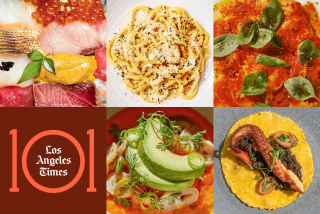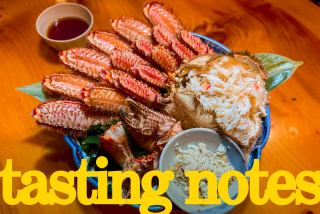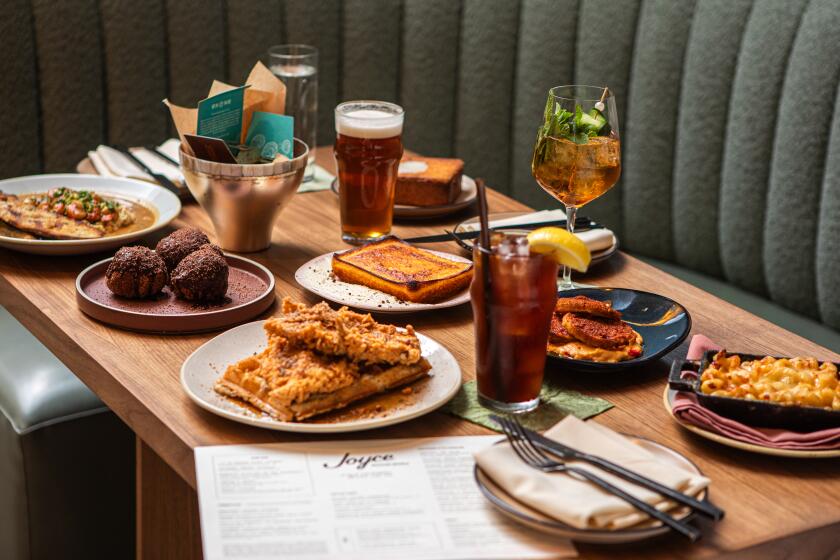The Etiquette of Using Chopsticks
Question: I’ve been invited to dinner at a Japanese restaurant and would like to know the traditional customs governing chopstick etiquette.
Answer: The Japanese custom of eating with chopsticks, hashi, was adopted from China almost 2,000 years ago, according to Susan Fuller Slack, author of “Japanese Cooking” (HP Books: $9.95, 1985). She goes on to explain that chopstick and table etiquette were developed by court aristocracy and Buddhist clergy between the 12th and 15th centuries. Later, during the Edo period (1603-1868), these customs became popular throughout the country.
Japanese chopsticks can vary in shape but are shorter and lighter weight than the Chinese version. Those for everyday use are made of woods such as bamboo, pine, cypress and white birch. Chopsticks for more formal use are often slightly longer and made of cedar, ivory or lacquered wood inlaid with abalone or mother-of-pearl.
Traditional customs still followed today include:
--At the beginning of the meal, chopsticks are picked up with one hand, then transferred to the other for eating.
--Ends of chopsticks are moistened before use by dipping them into soup or hot tea.
--The clean, unused ends are used for taking food from a communal serving dish unless a pair of serving chopsticks is provided for everyone’s use.
--When not in use, the ends of chopsticks should be placed on special chopstick rests, hashi-oki, pointing toward the left. Do not lean chopsticks against a food dish.
--Chopsticks should not be scraped together to remove pieces of food.
--Do not point with chopsticks.
--Never pass food from person to person with chopsticks.
--Do not permit chopsticks to stand upright in dishes of food.
Q: I have heard that there is a chicken that produces an egg that is entirely or relatively free of cholesterol. Is this true?
A: Although they’ve heard this question many times, representatives of the American Egg Board say no such egg exists.
Q: While cleaning out my garage recently, I found a cast-iron Dutch oven someone gave me some time ago. I know it needs to be seasoned before using, but there are no directions. Can you help?
A: The purpose of seasoning cast-iron cookware is to prevent rust and to keep foods from sticking. Begin by washing the pan with mild, soapy water and a stiff brush, then rinse and dry thoroughly. Rub a thin layer of oil over the entire surface of the pan and lid. Place both in the oven and bake at 325 degrees 1 hour. Turn off the oven heat, but keep the door closed and allow the pan to cool to room temperature inside the oven.
Cast-iron cookware will continue to turn black with use and the pores of the iron will be sealed. After each use the pan should be washed, rinsed and dried. Never scour or put in the dishwasher. Always apply a thin coating of oil to the cooking surface before storage.
Q: I have a recipe for homemade ice cream that calls for Junket. It is sometimes very hard to find--is there a substitute item?
A: Junket (or rennet) tablets coagulate milk and are used in making cheese and desserts. We don’t know of a substitute for these tablets, but they are available through The Vermont Country Store, Mail Order Office, P.O. Box 3000, Manchester Center, Vt. 05255-3000. Cost for a package of 36 tablets is $4.95, plus $1.88 shipping to California.
Address questions on food preparation to You Asked About ..., Food Section, The Times, Times Mirror Square, Los Angeles 90053. Personal replies cannot be given.
More to Read
Eat your way across L.A.
Get our weekly Tasting Notes newsletter for reviews, news and more.
You may occasionally receive promotional content from the Los Angeles Times.










